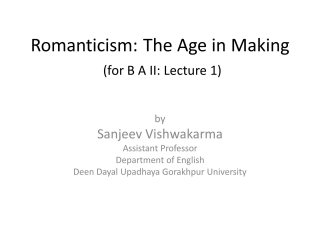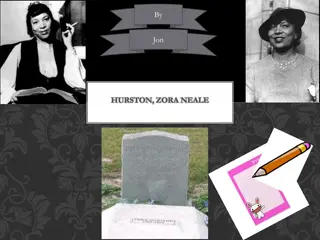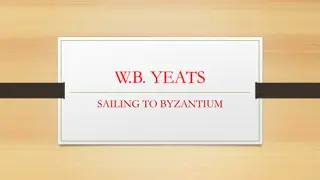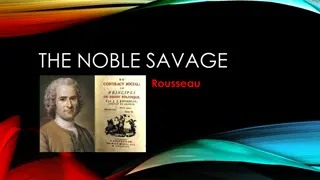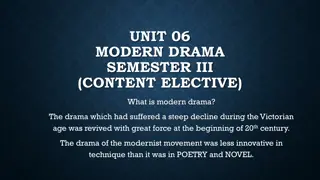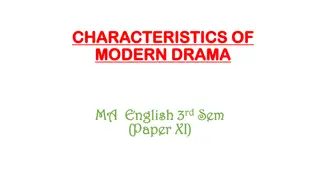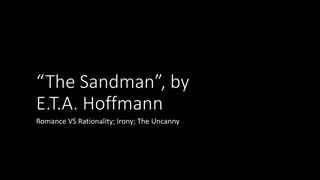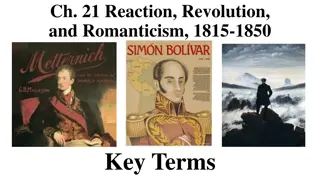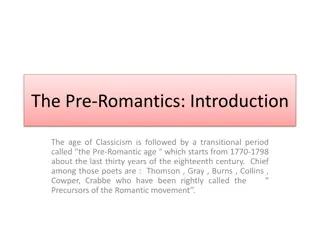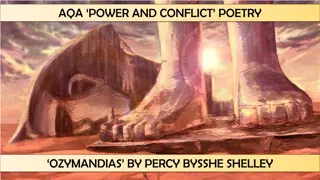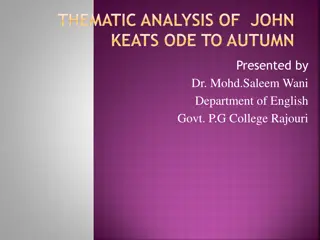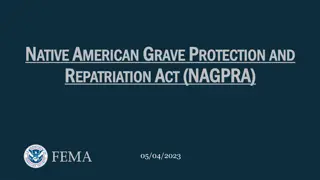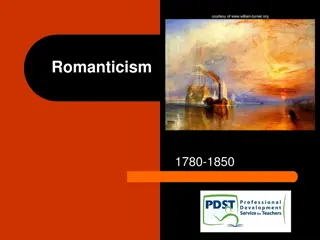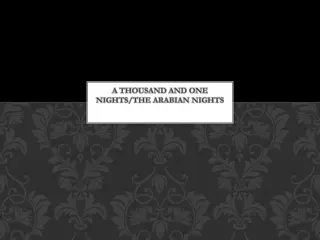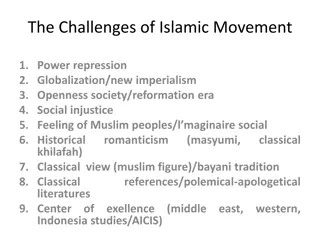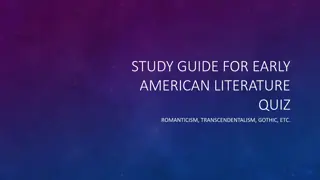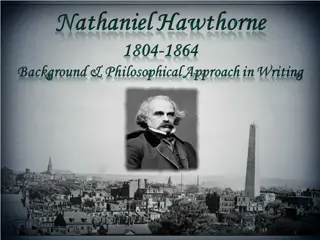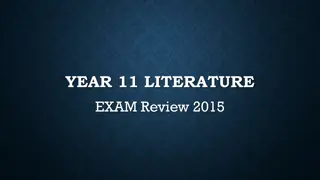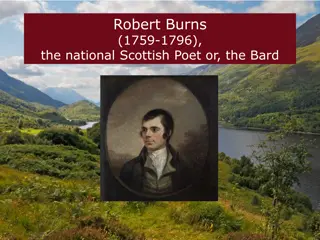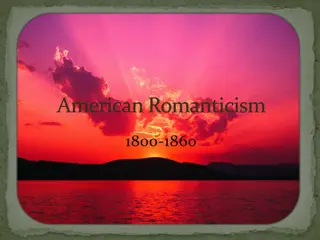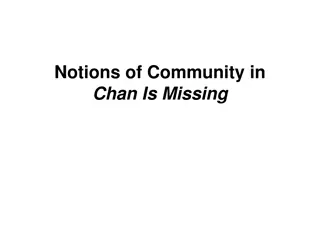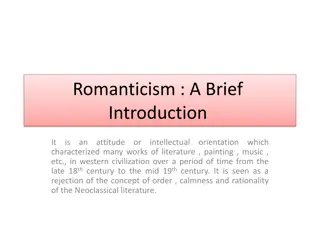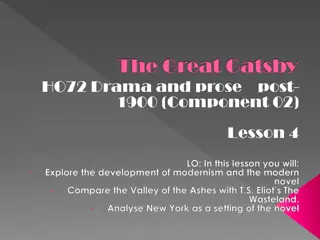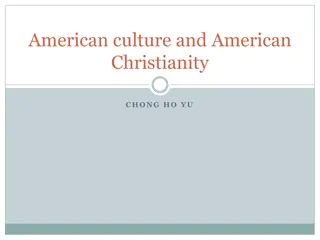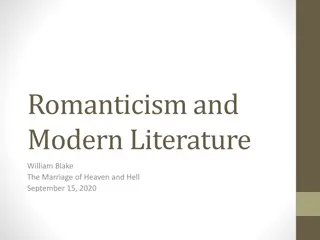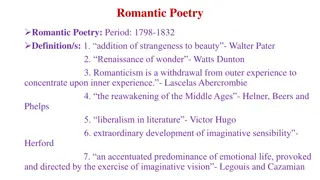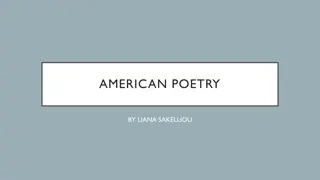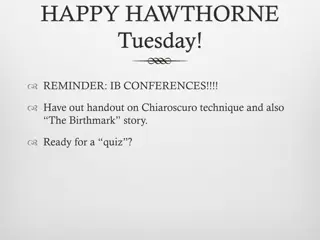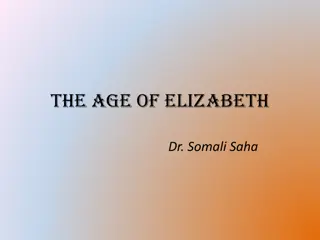Romanticism: The Age in Making
Explore the origins and characteristics of Romanticism in this informative lecture, covering the Enlightenment, American Independence, and the shift away from Enlightenment Neo-classicism.
19 views • 20 slides
Liberty & The Age of Enlightenment The American Battlefield Trust
The Age of Enlightenment, with its emphasis on natural law, liberty, progress, and constitutional government, greatly influenced American thinking and the Revolutionary War. Key figures like John Locke and Sir William Blackstone contributed ideas of social contract and law that shaped American gover
2 views • 15 slides
Zora Neale Hurston: African-American Writer of the Harlem Renaissance
Zora Neale Hurston, born in Notasulga, Alabama, in 1891, was a prominent African-American writer known for her works reflecting the African-American culture and folklore. Growing up in Eatonville, Florida, and later studying at Barnard College, she stood out among her contemporaries for her portraya
2 views • 4 slides
Overview of AANAPISI Program in the United States
The Asian American and Native American Pacific Islander Serving Institutions (AANAPISI) Program aims to support institutions with a minimum of 10% Asian American and Native American Pacific Islander undergraduate enrollment. Currently, there are 54 funded AANAPISI institutions across 16 states and t
0 views • 13 slides
Life and Achievements of W.B. Yeats
W.B. Yeats, the renowned Irish poet and writer, made significant contributions to English-language poetry in the 20th century. His life was marked by his interest in pagan beliefs, meeting Maud Gonne, and involvement in the Irish Literary Revival. Yeats' achievements include a blend of Irish folklor
1 views • 26 slides
The Concept of the Noble Savage in Frankenstein by Mary Shelley
The concept of the noble savage, popularized by Jean-Jacques Rousseau and reflected in Mary Shelley's novel Frankenstein, explores the idea that humans are inherently good in their natural state. Shelley portrays this through the creature, who, despite his primitive nature, displays love and kindnes
0 views • 6 slides
Dark Romanticism: Exploring a Gothic Literary Sub-genre
Overview of Dark Romanticism, a literary sub-genre emerging from the Transcendental movement but notably less optimistic. Explore its characteristics focusing on the tragic, characters prone to sin and self-destruction, and nature depicted as dark and mysterious. Learn about notable authors like Edg
0 views • 11 slides
Evolution of Modern Poetry in the 20th Century
Modern poetry in English emerged in the early 20th century as a reaction to Victorian formalism. Modernists drew inspiration from diverse literary traditions, including Greek, Chinese, and Japanese poetry, to create works that depicted social changes and the impact of World War I. Themes of material
1 views • 7 slides
Exploring Modern Drama: History and Characteristics
Modern drama, revived in the early 20th century after a decline in the Victorian age, encompasses realism, plays of ideas, romanticism, and poetic elements. English drama during the modernist period is categorized into phases marked by influential playwrights like Henrik Ibsen, G.B. Shaw, T.S. Eliot
0 views • 9 slides
Evolution of Modern Drama in the 20th Century: Characteristics and Trends
Modern drama in the 20th century experienced a revival and various trends. Realism was a significant quality where dramatists like Ibsen focused on portraying real problems of life. Problem plays emerged, addressing societal issues like marriage and justice. Modern drama shifted towards being a stag
1 views • 14 slides
Exploring the Poetry and Life of Wilfred Owen
Delve into the profound journey of poet Wilfred Owen, from his dreams of Romanticism to the harsh realities of war. Encounter his mental struggles, collaborations with Siegfried Sassoon, and the deep-seated themes of religion, death, and nature in his works. Uncover the powerful impact of Owen's exp
0 views • 41 slides
Exploring E.T.A. Hoffmann's "The Sandman": A Study in Romanticism, Irony, and the Uncanny
Delve into the world of E.T.A. Hoffmann's literary masterpiece "The Sandman," where themes of Romanticism versus rationality, irony, and the uncanny intertwine. Through the characters of Nathaniel and Clara, the story explores the tensions between passion and reason, imagination and reality. Dive de
0 views • 12 slides
Analysis of W.B. Yeats' Poem "The Second Coming" in Modern British and American Poetry
The analysis delves into the prominent themes of mortality, violence, and prophecy in W.B. Yeats' well-known poem "The Second Coming." Yeats' exploration of the idea of a Second Coming as a harbinger of a tumultuous future and his use of powerful symbols like the falcon and gyres showcase his distin
0 views • 8 slides
Key Terms in Ch. 21: Reaction, Revolution, and Romanticism, 1815-1850
The key terms discussed in Chapter 21 include principle of legitimacy, balance of power, ideology, conservatism, principle of intervention, ultraroyalists, ministerial responsibility, and liberalism. These terms highlight important political philosophies and concepts during the post-Napoleonic era a
0 views • 17 slides
Exploring the Pre-Romantic Poets and Themes
The Pre-Romantic period, a transition from Neoclassicism to Romanticism, is characterized by poets like Thomson, Gray, Burns, and Collins. These poets ushered in a shift towards emotional expression, nature themes, and a rejection of urban life. Pre-Romantic poetry focused on nature, sensibility, me
1 views • 13 slides
Exploring Percy Bysshe Shelley's "Ozymandias" in AQA Power and Conflict Poetry
Delve into the world of Percy Bysshe Shelley's "Ozymandias" as part of the AQA Power and Conflict Poetry module. Uncover the themes of power and conflict, understand the historical context, and analyze the symbolism of statues in the poem. Engage with oracy tasks, context summaries, and poem analysi
0 views • 21 slides
Thematic Analysis of Keats' Ode to Autumn in the Context of Romantic Literature
The thematic analysis of John Keats' "Ode to Autumn" explores the poem's reflection on the beauty of seasonal transitions, emphasizing the melancholic yet serene nature of autumn. Presented by Dr. Mohd Saleem Wani, the analysis delves into Keats' ability to find beauty in the changing landscape and
0 views • 10 slides
Native American Repatriation and NAGPRA Overview
The Native American Graves Protection and Repatriation Act (NAGPRA) enacted since November 1990 establishes ownership of cultural items excavated on Federal or Tribal land. It requires returning such items to Native American descendants and affiliated tribes. The Act also criminalizes trafficking in
1 views • 8 slides
Exploring Atmosphere and Themes in Frankenstein Through Letters
The novel "Frankenstein" by Mary Shelley unfolds through a series of letters that set the scene for a haunting narrative. The story begins with explorer Robert Walton writing to his sister about his ambitious voyage to the North Pole. Through letters, themes of loneliness, despair, and the danger of
0 views • 13 slides
Romanticism in Art: Overview of the Romantic Period & Influential Painters
Challenging Neo-Classicism, Romanticism (1780-1850) in art focused on music, literature, and painting. Influenced by historical events like the French Revolution and proponents like Delacroix, Gricault, and Turner, this period saw a shift towards nature, emotion, and a new perspective on art.
1 views • 17 slides
Orientalism and Imaginative Imperialism in the Arabian Nights
This content discusses the intertwining of Orientalism, imperialism, and literature in works like "A Thousand and One Nights" (The Arabian Nights). It explores how intellectual and cultural energies influenced the imperialist perspective and translation of these texts, revealing deeper insights into
0 views • 8 slides
Challenges Faced by the Islamic Movement: A Comprehensive Overview
The challenges confronting the Islamic movement are multifaceted, encompassing issues such as power repression, globalization, social injustice, historical romanticism, and the need for social reform. From the struggle against religious democracy to the metamorphosis of new Islamic movements, this i
0 views • 8 slides
Washington Irving: Father of American Fiction and Pioneer of American Romanticism
Washington Irving, an influential American author of the early 19th century, is revered as the Father of American fiction. Known for iconic works like "The Legend of Sleepy Hollow" and "Rip Van Winkle," Irving played a crucial role in establishing American literature as an independent art form. His
1 views • 14 slides
Understanding Romanticism and Transcendentalism in Early American Literature
Exploring the defining characteristics of American Romanticism, such as a focus on nature, individualism, and self-reliance, alongside the beliefs and teachings of Transcendentalists like Thoreau and Emerson. Contrasting these literary movements as reactions to established norms and traditions, emph
0 views • 16 slides
Nathaniel Hawthorne: Life, Background, and Influence on Romanticism
Nathaniel Hawthorne, born in Salem to a Puritan background, faced family history shadows and solitude. Despite an initial setback with his writing, he emerged as a prominent figure in American Romanticism. With a unique style, Hawthorne contributed to the literary movement focusing on past settings
0 views • 10 slides
The Great Gatsby: A Reflection of American Culture in the Roaring Twenties
The Great Gatsby, a timeless piece of literature, showcases various aspects of American culture during the roaring twenties. It delves into the pursuit of the American dream, the romanticism of the era, relevance of its ideas even today, and the destructive power of obsession. Through intricate pros
1 views • 49 slides
The Legacy of Robert Burns: Scotland's National Poet
Robert Burns, also known as the Bard, was a significant figure in Scottish literature, representing Pre-Romanticism with his exploration of emotions and folk literature. His enduring appeal led to his influence on liberalism and socialism. Burns collected and adapted folk songs, with "Auld Lang Syne
0 views • 16 slides
Exploring American Romanticism: The Spirit of Nature and Imagination
American Romanticism from 1800-1860 was a movement that valued intuition and feeling over reason, embracing inner experiences and the power of imagination. It sought to escape the corrupting influence of civilization, embracing unspoiled nature and youthful innocence. The era championed individual f
1 views • 10 slides
Exploring Asian American Identity Through "Chan Is Missing" by Wayne Wang
Chan Is Missing" (1982) directed by Wayne Wang is a groundbreaking Asian American independent feature film that delves into themes of Asian American identity, hyphenated identity, assimilation, and hybridity. The film, shot on a shoestring budget in San Francisco's Chinatown, showcases the community
0 views • 26 slides
Understanding Romanticism: A Brief Introduction to Literary Movement
Romanticism, a significant literary movement from the late 18th to mid-19th century, emphasized individuality, subjectivity, emotion, and the supernatural. It marked a departure from Neoclassical ideals of order and rationality. Key characteristics include subjectivity, spontaneity, love of the supe
0 views • 8 slides
Exploration of British Romantic Literature through the Works of Samuel Taylor Coleridge
British Romantic Literature underwent a significant shift from the strict rationality of the 18th century to embracing imagination, nature, and emotion in the 19th century. This shift is exemplified through the works of Samuel Taylor Coleridge, particularly his unfinished epic poem "Christabel." The
0 views • 5 slides
Exploring Modernism and the Modern Novel in The Great Gatsby
This lesson delves into the development of modernism and the modern novel through a comparison of The Great Gatsby's Valley of the Ashes with T.S. Eliot's The Wasteland. It discusses the transition from Romanticism to Realism to Modernism in literature, highlighting how Fitzgerald merged poetic Roma
0 views • 7 slides
Influence of American Culture on American Christianity: A Critical Analysis
This content explores the relationship between American culture and American Christianity, discussing how religion reflects the cultural values of individualism, optimism, and the concept of a blessed nation. It delves into the concept of Biblical individualism, the influence of prosperity gospel, a
1 views • 7 slides
William Blake's The Marriage of Heaven and Hell: Exploring Romanticism and Modern Literature
William Blake's "The Marriage of Heaven and Hell" delves into themes of contraries, creative imagination, and Gnosticism, challenging conventional beliefs about good and evil, and the relationship between the physical and metaphysical worlds. Blake's work critiques traditional religious notions, emp
0 views • 10 slides
Exploring John Keats' Poetry and Romanticism in "On the Grasshopper and Cricket
Dive into the world of John Keats' poetry with a focus on "On the Grasshopper and Cricket," exploring themes of nature, beauty, and seasonal symbolism. Understand the Romantic Age context and discuss the significance of symbols like the grasshopper and cricket in conveying deeper meanings within the
0 views • 9 slides
Exploring the Romantic Era: Poetry, History, and Major Poets
A detailed exploration of Romantic Poetry from 1798-1832, encompassing the defining characteristics, historical background, major poets including Wordsworth and Keats, and the influence of key events like the French Revolution. Romanticism is characterized by subjectivity, imagination, love for the
0 views • 4 slides
Exploring Realism: An Artistic Movement in the 19th Century
Realism was an artistic movement that emerged in France in the 1850s, challenging the predominant Romanticism by depicting real and typical contemporary life with truth and accuracy. Led by main realist painters like Gustave Courbet, Realism sought to capture ordinary people and situations, embracin
0 views • 8 slides
American Literature Through the Ages
Explore the rich tapestry of American literature covering American Indian culture, New England Puritanism, the 18th century American Enlightenment, and the American Renaissance. Discover the oral traditions of American Indian tribes, the puritanical values of New England, the democratic origins of A
0 views • 17 slides
Introduction to Romantic, Gothic, and Chiaroscuro in Literature and Art
Explore the fascinating worlds of Romanticism, Gothic literature, and Chiaroscuro technique through images and informative content. Learn about the themes, styles, and key elements of these artistic movements that have influenced literature and art. Engage with the duality of light and darkness, the
0 views • 17 slides
The Literary Legacy of Elizabethan Era: Poetry, Drama, and Shakespearean Masterpieces
The Elizabethan Age marked a rich literary period with the emergence of new classicism and romanticism. Notable poets like Spenser, Donne, and Wyatt, along with pre-Shakespearean dramatists, paved the way for the renowned works of William Shakespeare. His poems and plays, ranging from comedies to tr
0 views • 11 slides
